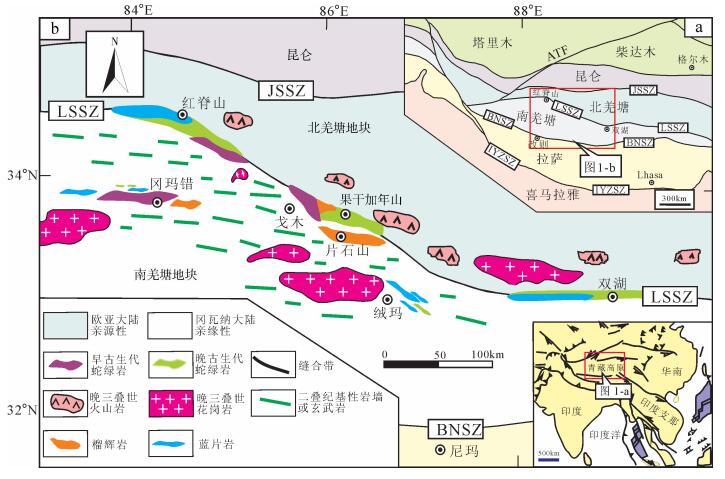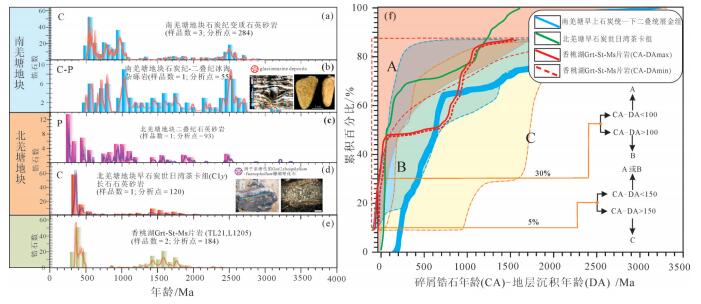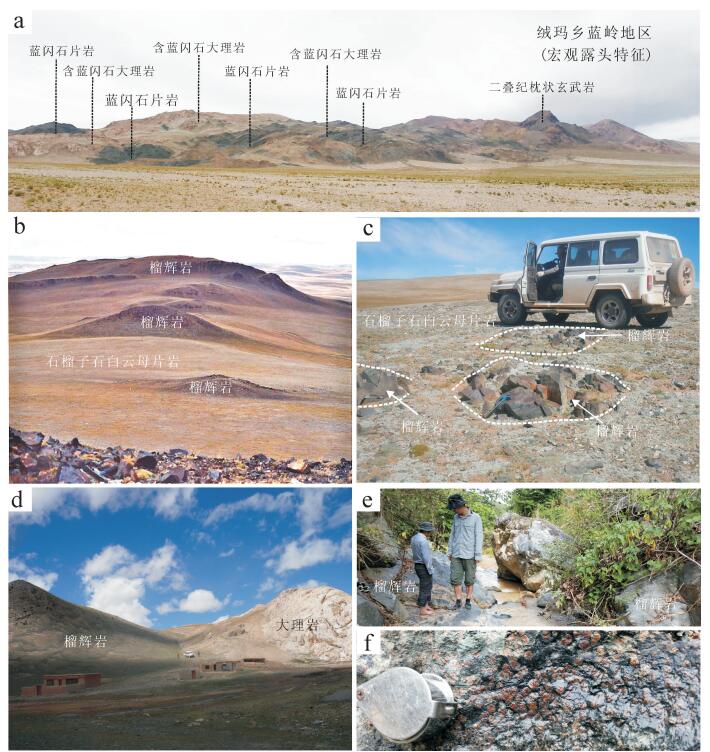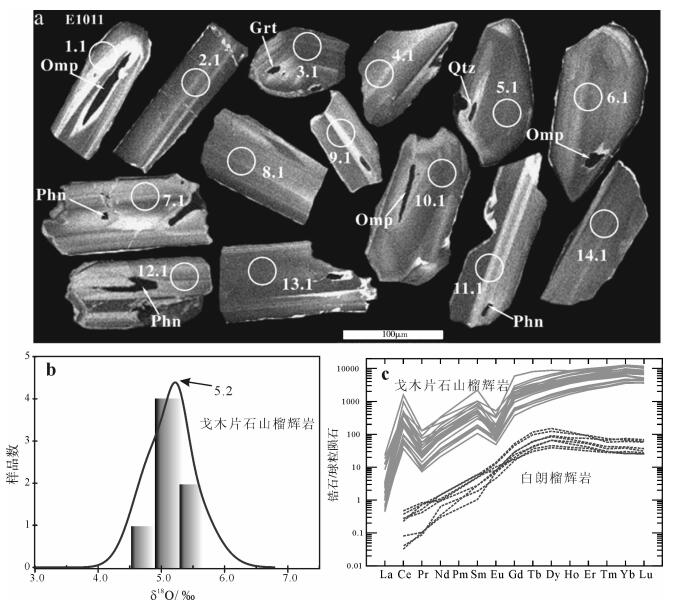High pressure metamorphic belt in central Qiangtang, Tibetan Plateau: Progress and unsolved problems
-
摘要:
羌塘中部高压变质带是目前青藏高原内部延伸规模最大的高压变质带,是理解特提斯演化的关键地质记录。高压变质带主要沿龙木措-双湖-澜沧江缝合带一线出露,主要由榴辉岩、蓝片岩、石榴子石多硅白云母片岩及少量高压麻粒岩组成。其中,榴辉岩主要出露于戈木、果干加年山、冈玛错、巴青及滇西的勐库地区,主要呈透镜状产于石榴子石多硅白云母片岩中。除巴青地区的榴辉岩外,其余地区榴辉岩的峰期变质温度较低且含有硬柱石及其假象,峰期变质条件位于硬柱石榴辉岩相稳定区域,是洋壳冷俯冲的产物。虽然对于戈木地区榴辉岩锆石成因仍有争议,但已有资料显示,羌塘中部高压变质带主体变质时代集中在晚三叠世,其相关高压变质岩石的折返可能与洋盆的闭合及随后的陆-陆碰撞相关。近期研究表明,羌塘中部可能存在二叠纪低温高压变质岩,折返于大洋俯冲阶段,可能与洋岛或海山的俯冲及引发的俯冲侵蚀作用相关。此外,羌塘香桃湖地区出露早古生代的基性高压麻粒岩,是冈瓦纳大陆北缘陆块拼贴的记录。因此,对羌塘中部高压变质带进行进一步系统的研究工作,对于深入理解冈瓦纳北缘构造演化及古特提斯的俯冲与闭合过程具有重要的意义。
Abstract:A 500km-long high-pressure metamorphic belt has been documented in the central Qiangtang Block of northern Tibet, which is thought to have constituted the crucial geological archives of subduction and exhumation of Paleo-Tethys oceanic lithosphere. The high-pressure metamorphic rocks are mostly exposed along the Longmu Co-Shuanghu suture zone, and are composed of eclogites, blueschists, garnet-phengite-schists (Grt-Phn schists), and minor high-pressure mafic granulites. The eclogites in central Qiangtang are reported from Gemu, Guoganjianian Mt., Gangma Co, Baqing, and Mengku area, and occur mainly as blocks or small lenses in Grt-Phn schists. Apart from newly discovered Baqing eclogites, most eclogites from central Qiangtang Block are characterized by low peak temperatures and presence of lawsonite or pseudomorphs of epidote + paragonite, and their peak P-T results lie mainly in the lawsonite-eclogite field. The ages of most eclogites and blueschists from central Qiangtang block have been constrained as Late Triassic which are regarded as the results of closure of the Paleo-Tethys Ocean and following continental collision. Furthermore, the Permian high-pressure metamorphic rocks were also identified and their P-T-t paths revealed a complete evolutional history for the subduction erosion in response to the subduction of seamounts (or oceanic islands). Moreover, the discovery of Silurian high-pressure granulites in the central Qiangtang block indicates the existence of a previous collisional event on the northern margin of the Indo-Australian Gondwana. Hence, further comprehensive studies of the high-pressure metamorphic belt in central Qiangtang will provide valuable insights into the tectonic evolution of the north margin of Gondwana during the early Paleozoic and the opening and closure of the Paleo-Tethys Ocean.
-
Keywords:
- Tibetan Platean /
- Qiangtang block /
- eclogite /
- blueschist /
- Paleo-Tethys Ocean
-
白云鄂博稀土-铌-铁矿床是世界级的综合性矿床,蕴含着稀土、铌、铁、钪、萤石等多达26种矿产资源,极具经济和科学研究价值。自1927年发现以来,已经形成了主矿、东矿、西矿、东介勒格勒、菠萝头5个主要矿段,其中铁矿石总储量约14.68×108 t[1]。经过60多年的开采,最早开发的主矿、东矿露天开采服务年限到目前仅有4~5年。东介勒格勒和菠萝头矿段的保有资源量少,品位低,矿体小而散。因此,铁矿保障资源严重不足,寻找接替资源迫在眉睫。
自20世纪80年代以来,国内外众多学者在赋矿岩石的成因[2-11]、成岩成矿时代[10-24]、稀土矿物学[25-30]等方面取得一系列重要进展,为碳酸岩型矿床成矿理论发展做出了突出贡献。尽管对白云鄂博赋矿岩石的成因目前仍存在不同认识,但越来越多的地质学、地球化学证据支持中元古代岩浆碳酸岩的成因观点[31-32],即白云鄂博赋矿岩石为白云石碳酸岩。然而,白云石碳酸岩的形成受什么构造控制?铁矿体在白云石碳酸岩中的空间分布规律受什么控制等科学问题仍亟待解决。
白云鄂博矿区地处华北克拉通北缘渣尔泰-白云鄂博-化德中元古代裂谷带中(图 1)。华北克拉通是世界上最古老的克拉通之一,经历了自元古宙以来复杂的构造演化[33-36],包括古元古代末期—新元古代的多期裂谷事件[37]、古生代与俯冲有关的多期岩浆[13, 38]、变质和变形作用[19, 39]等。长时间的构造演化使得矿床构造地质情况十分复杂[40-41]。长期以来对白云鄂博的构造研究主要聚焦在其大地构造属性及矿区外围的构造变形上,对白云鄂博主要控矿构造形迹及其对矿床控制作用的研究仍较薄弱。一直以来,白云鄂博找矿模型是以向斜控矿作为指导,这在早期控制白云鄂博矿床浅部资源起到了非常好的效果。然而,随着矿区的进一步开采揭露和深部钻孔的进一步施工,矿区的构造样式和成矿地质模型也需要进一步研究[32]。
![]() 图 1 中国大地构造纲要图(a)、华北克拉通中元古代裂谷带简图(b)和白云鄂博地区大地构造分区图(c)[33]Figure 1. Tectonic sketch map of China (a) and sketch map showing Mesoproterozoic rift zones in the North China Craton (b) and the geotectonic divisions map of Bayan Obo area (c)
图 1 中国大地构造纲要图(a)、华北克拉通中元古代裂谷带简图(b)和白云鄂博地区大地构造分区图(c)[33]Figure 1. Tectonic sketch map of China (a) and sketch map showing Mesoproterozoic rift zones in the North China Craton (b) and the geotectonic divisions map of Bayan Obo area (c)本文围绕白云鄂博主要控矿构造形迹及其对矿床的控制作用,通过对主矿区、东矿区精细的矿田构造填图,查明矿区构造变形性质、变形序次及其对矿体的形成控制及破坏作用,结合铁矿体空间分布规律,探讨各构造形迹与成矿的关系,对矿区深部和外围找矿部署工作具有重要的指导意义。
1. 区域地质构造特征
白云鄂博矿床位于乌兰宝力格深断裂和白银角拉克大断裂2条断裂带的交汇处(图 1-c),这2条断裂带基本控制了区内的构造格局、成矿作用及岩浆活动[8]。乌兰宝力格断裂位于矿区北侧10 km,是赤峰-白云鄂博断裂的一部分,常被作为华北克拉通与北侧古亚洲洋俯冲增生杂岩的界线,沿断裂带发育多期海西期岩浆侵位和火山事件。白银角拉克-宽沟大断裂的展布方向大致为近东西向,西至白银角拉克地区,东至宽沟地区,全长约40 km。西侧白银角拉克地区显示倾向北的逆断层性质,断裂标志发育明显,在东侧宽沟地区的断裂特征不显著,脉岩常沿断裂出现,向东与乌兰宝力格深大断裂带汇合。
除区域性深大断裂外,1:5万专题地质填图显示矿区及外围的构造情况十分复杂。断裂构造以近东西向产出的由北向南的逆冲推覆为突出特征,大小断裂密布,多呈叠瓦式产出。褶皱构造存在多期次不同方向和不同性质的叠加褶皱变形构造,大中型褶皱构造的枢纽倾伏较缓,轴向近东西,而小型褶皱大多零星分布于其内部。研究区最主要的褶皱构造为宽沟背斜。宽沟背斜的轴向近东西向,且枢纽向西倾伏,核部为古元古界花岗片麻岩及宝音图群变质杂岩,两翼为白云鄂博群。该背斜东端南翼被海西期花岗岩侵入,西部南翼以往被认为发育次级向斜(即白云向斜),白云鄂博矿床处于宽沟背斜的南翼。
矿区断裂构造特别发育(图 2),包括近东西向、北西西向、北西向、北东向和近南北向,导致矿区岩石地层单元走向上不连续[19]。矿区主要断裂构造以近东西向为主,包括北侧的赛乌素韧性剪切带、宽沟断裂、白云鄂博矿区南侧的逆冲断层和韧性剪切带等[19]。从矿区碳酸岩和其他岩石单元的变形特征看,无论是赋矿白云石碳酸岩还是长城系都拉哈拉组、尖山组、蓟县系比鲁特组,均显示韧性剪切变形的特征,矿区整体应处于一个巨形韧性剪切带中,矿区北侧的赛乌素韧性剪切带和南侧的韧性剪切带[19]可能都是该巨型韧性剪切带的一部分,但具体发育特征仍需进一步的工作证实。
![]() 图 2 白云鄂博主、东矿区地质及构造分布图1—第四系;2—白垩系固阳组;3—长城系尖山组;4—长城系都拉哈拉组;5—新太古界乌拉山群;6—二叠纪二长花岗岩;7—黑云母花岗闪长岩;8—中元古代白云石碳酸岩;9—花岗岩脉;10—石英斑岩脉;11—闪长岩/闪长玢岩脉;12—碳酸岩脉;13—碱性岩脉;14—钠角闪石岩脉;15—钠辉石钠角闪石碱性岩脉;16—铁矿化体;17—低品位铁矿化带;18—实测或推测正断层;19—实测或推测逆断层;20—实测或推测性质不明断层;21—韧性剪切带;22—断层序号Figure 2. Geological and structural map of the main mine and east mine in the Bayan Obo ore deposit
图 2 白云鄂博主、东矿区地质及构造分布图1—第四系;2—白垩系固阳组;3—长城系尖山组;4—长城系都拉哈拉组;5—新太古界乌拉山群;6—二叠纪二长花岗岩;7—黑云母花岗闪长岩;8—中元古代白云石碳酸岩;9—花岗岩脉;10—石英斑岩脉;11—闪长岩/闪长玢岩脉;12—碳酸岩脉;13—碱性岩脉;14—钠角闪石岩脉;15—钠辉石钠角闪石碱性岩脉;16—铁矿化体;17—低品位铁矿化带;18—实测或推测正断层;19—实测或推测逆断层;20—实测或推测性质不明断层;21—韧性剪切带;22—断层序号Figure 2. Geological and structural map of the main mine and east mine in the Bayan Obo ore deposit矿区一带主要出露中元古界白云鄂博群,主要包括长城系都拉哈拉组、尖山组,蓟县系哈拉霍格特组和比鲁特组,其南西两侧出露花岗岩岩基,北侧花岗岩则呈岩株产出。区内地质构造方向与东西褶皱带的方向一致,中元古界白云鄂博群的走向、重要断层的走向、花岗岩岩基长轴方向及岩脉侵入方向,均为东西向;节理亦以东西向的纵节理最发育;矿化地区亦呈东西带状,说明成矿作用受东西向构造的控制。
2. 白云鄂博矿区控矿构造特征
2.1 褶皱构造特征
白云鄂博附近地区地质构造为一大复背斜形式,轴向为东西或近东西向。错综的逆断层和南北向断层使构造更加复杂化,因此大复背斜中的小背斜和小向斜,亦呈多种形式出现。因地区不同,倾斜方向及倾斜角度不同。其主要褶皱分述如下。
(1) 宽沟背斜构造:为复背斜的中央背斜部分。其位置在哈拉达岭以南主矿、东矿以北的宽沟。构成核部的岩石为震旦系底部的岩层。背斜构造向西倾没,因此长城系都拉哈拉组一段和二段仅出现于背斜的东段,即查汗鄂博—尖山一带,向西则仅有长城系尖山组一段岩层出露。
背斜东段两翼的岩层,分别向两翼倾斜,倾角大于45°,最大至60°~70°。西段岩层倾角亦陡。再向西至阿布达,此背斜构造为一横断层所切。
宽沟背斜东段核部长城系都拉哈拉组一段和二段,受显著的混合岩化作用,一部分成为混合岩。向西至尖山一带,背斜核部有小的闪长岩侵入体出露,并有石英脉断续出现。阿布达背斜核部的都拉哈拉组一段岩层,亦受混合岩化作用形成混合岩。
(2) 北部向斜构造:宽沟背斜的北翼,向东至查汗鄂博,因断层关系造成岩层缺失现象,再向北在蓟县系比鲁特组一段之上,哈拉霍圪特组又重新出露,并向北倾斜,造成以蓟县系比鲁特组一段为褶轴的倒转向斜构造。向斜构造的东段构造较复杂。向北哈拉霍圪特组岩层重复出露多次,并均向北倾斜,造成多次倒转褶皱。向斜的西段向北,蓟县系比鲁特组岩层亦自成向南倒转的褶皱多次,直至白云布拉格以东地区。
(3) 南部“向斜”构造:宽沟背斜南部,从东介勒格勒南部和主矿、东矿北部的都拉哈拉组产状看,向形是存在的。基本上是以比鲁特组一段硅质板岩为核部的向形构造,轴向为东西向。但本次专题填图的结果显示,主要的赋矿岩石应为沿断裂产出的白云石碳酸岩,如果将白云石碳酸岩剔除,向形两侧的岩层岩性及厚度都不具有对比性,故南部“向斜”构造究竟是否存在还是被侵入岩改造,仍需进一步研究。
2.2 断层构造特征
矿区受多期叠加褶皱变形的影响,韧性剪切、脆性断层非常发育[42]。构造填图结果显示,矿区从中元古代—海西期至少发育4期构造活动,包括近东西向控岩断层(F1)、近东西向逆-平移断层(F2)、近东西向褶皱和韧性剪切构造、北东向左行走滑正断层(F3)(图 2),它们不仅控制矿床的形成,在很大程度上也影响矿床的破坏与保存,同时也控制着矿体的形态、产状。
2.2.1 近东西向控岩断层特征(F1)
该断层主要沿白云石碳酸岩与顶板长城系尖山组界线分布(图 2),贯穿整个主矿、东矿区,其控制了白云石碳酸岩的产出和矿体的形成。断层倾角一般大于60°,断层面平直,整体走向近东西向,断层面局部呈舒缓波状。在露头上,表现为白云石碳酸岩和顶板板岩呈断层接触,断层带内从白云石碳酸岩→比鲁特组硅质板岩依次出现断层泥、构造角砾岩和碎裂岩。根据剪节理、构造透镜体等运动学标志(图版Ⅰ),判定该断层为正断层,与前人划分的高位断层和东介勒格勒断层性质一致。从图版Ⅰ可以看出,断层面产状呈现2组:一组为154°∠84°、134°∠75°;另一组为230°∠65°、210°∠63°,推断其可能为共轭张性断层系,形成这2组断层的应力场应为近南北向拉伸、东西向挤压。此外,沿构造带上含矿碳酸岩中常见小型包卷层理,同生褶皱构造,滑动搓碎的角砾等,其中较清晰和具指向意义的是同生褶皱构造,可能属于早期裂谷作用形成的伸展断层。
伸展断层是本区的控岩主断层,控制了含矿白云石碳酸岩侵位,高位同生断层及白云石碳酸岩是这个阶段的产物。这与中元古代白云鄂博裂谷拉张环境匹配。虽然本区遭受过多期构造的强烈改造,裂谷早期的构造在局部地区已发生解体或被掩盖,但从剖面上,裂谷早期同生构造依然控制断陷盆地的发展及演化。后期联合地体的拼贴碰撞导致的挤压褶皱可能主要表现在地壳表层。深部构造样式还保留了早期构造的特点。
该断层为白云石碳酸岩侵位同期或更早发育的一组陡倾的正断层,主要证据有断层角砾岩中往往见萤石化、磁铁矿化等矿化,为主要的控岩控矿断层。
2.2.2 近东西向逆-平移断层特征(F2)
该组断层在主矿、东矿南部非常发育,其产于白云石碳酸岩顶部的板岩中,紧邻控岩断层,断层延伸稳定,在东矿东部、东矿西部、主矿东部、主矿中西部具有露头显示(图版Ⅱ)。断层带宽度一般为5~20 m,局部见构造破碎带,宽达25 m(东矿西端)。走向近东西向,倾向在160°~180°之间,倾角在75°~85°之间,擦痕产状为250°~255°∠10°~30°。根据擦痕、阶步、次级的剪节理判断,该组断层应为左行逆-平移断层,且以走滑为主。
构造填图结果显示,断层构造位于矿体南侧,产状也较矿体陡,很明显,断层切割深部矿体,对矿体造成破坏。
白云鄂博东矿15、16、17勘探线剖面显示(图 3),白云石碳酸岩与上部板岩界线延伸稳定,但在深部两者界线发生突变,且在突变的白云石碳酸岩中,在预计的断层带,均发现了基性岩脉的存在(WK15-0、WK16-04、WK17-04),这也验证了预期断层构造的存在。两者界线测量显示,深部矿体向上推移大于300 m,因断层以走滑为主,横向位移可能远大于300 m,故断层对矿体破坏性较大,很可能导致了主矿、东矿深部矿体向东推移。
2.2.3 近东西向韧性剪切构造
该组韧性剪切构造主要发生在主矿、东矿南侧,是一期非贯穿性构造,在矿区形成东西向的韧性剪切带。在矿区范围内,该带西起西矿南侧,向东经主矿、东矿南侧向东延伸,规模超过10 km。
该组韧性剪切构造在不同性质的岩石中有不同的表现:在细粒白云石碳酸岩中,变形不明显(图版Ⅲ-a);在矿体顶板富钾板岩中,由于岩石能干性较强,岩石受剪切发生脆性碎裂(图版Ⅲ-b);在细粒白云石碳酸岩与接触云母岩接触带,可以明显看到差异性韧性变形(图版Ⅲ-c);在钠长石发育的地段,可以明显看到早期钠长石脉透镜体化(图版Ⅲ-d);在萤石化发育的地段,眼球状构造异常发育(图版Ⅲ-e);糜棱岩中发育各种指向性清楚的显微构造,包括白云石碎斑、长石碎斑、石英波状消光等。白云石碎斑系列沿剪切破裂面发生滑移,拖尾构造显示运动方向为左旋剪切(图版Ⅲ-f)。此外,在矿区南部中元古界白云鄂博群尖山组糜棱岩化长石石英岩中还发育大量的矿物线理,一组与糜棱面理倾向垂直的钠铁闪石代表物质运移方向。
野外露头显示,受此韧性剪切带影响,主矿、东矿之间矿体上盘板岩陡倾的劈理十分发育(图版Ⅳ-a),侵入板岩中的碱性脉小型紧闭褶皱也非常发育(图版Ⅳ-b、c、d),在局部地段也可以看到近东西向、北西向的小型逆冲断层(图版Ⅳ-e、f),断层的规模和标志层位移显示,本期断层规模较小,对矿体的破坏有限。
2.2.4 北东向左行走滑正断层特征(F3)
该组断层构造主要见于主矿东部坑底和东矿北侧1480 m平台(图 4)。由于断层发育在白云石碳酸岩内部,岩石能干性较低,故在露头上延续性较好,但断层宽度较窄,断层泥和构造角砾岩不发育。断层走向为北东向,倾向南东(110°~120°),倾角陡立(68°~78°)。断层面上的擦痕显示,该断层具有左行走滑性质,属于正断层,导致了主矿、东矿位置的错动。主矿、东矿矿体中段平面图显示,该断层位移较小,对矿体的破坏有限。
根据其对白云石碳酸岩的切割关系,该构造形成于白云石碳酸岩侵位之后,同属于白云石碳酸岩侵位晚期的伸展环境的构造。
3. 构造控矿模式
3.1 矿区构造时序
根据不同构造相互间的切割关系及其与控岩控矿的关系,矿区内褶皱、断层和韧性剪切带时序应为:近东西向控岩断层(F1)→近东西向逆-平移断层(F2)→近东西向褶皱构造和韧性剪切构造→北东向左行走滑正断层(F3)。主要有以下证据。
近东西向控岩断层为矿区控岩主断层构造,其控制了含矿白云石碳酸岩侵位,断层角砾岩证据表明,该断层为白云石碳酸岩侵位同期或更早发育的一组陡倾的正断层;勘探线剖面图显示,近东西向逆-平移断层(F2)切割了铁矿体和白云石碳酸岩体,故F2晚于F1;精细的构造填图显示,北东向左行走滑正断层(F3)明显切割了早期形成的F1和F2断层,故F3断层形成最晚。近东西向褶皱构造和韧性剪切构造与F1、F2、F3的时序关系没有明显的地质证据,仅根据矿区应力场的转变推测,尚需要开展进一步的研究。
3.2 构造活动与区域地质演化的耦合
(1) 结晶基底形成期:大量的同位素年龄统计[43]显示,白云鄂博地区结晶基底的形成跨越了2个时期:新太古代(约2550 Ma)和古元古代(2040~1900 Ma)。其中,约2550 Ma的年龄记录,与华北克拉通早期的TTG岩类及早期花岗岩的集中侵位时代一致,为华北克拉通最重要的陆壳(活动陆缘、岛弧)增生、克拉通化峰期[44-50]。2040~1900 Ma年龄记录是一期碰撞造山事件的体现[51-52]。
(2) 裂谷形成期:中元古代,白云鄂博及其外围发育大量火成碳酸岩墙群和基性岩墙群,其形成时间与Columbia超大陆裂解事件(1.4~1.2 Ga)吻合,是超大陆最终裂解的产物[10, 33-34, 53]。矿区发育该裂谷系的北支,是由白云鄂博群组成的白云鄂博裂谷带。以裂谷沉积为主的白云鄂博群主要由一套碎屑岩、泥页岩、碳酸盐岩组成,并有碱性火山建造,与下伏结晶基底色尔腾山群呈角度不整合。其中,碎屑岩和碳酸盐岩沉积总厚度达万米,与白云鄂博群总厚度的比值可达0.9,说明白云鄂博群是在强烈拗陷中快速堆积,并伴随切割很深的同沉积断裂[54],矿区控制白云石碳酸岩产出的近东西向正断层正是裂谷形成阶段的构造响应。
(3) 俯冲碰撞造山期:早古生代志留纪晚期,华北板块与西伯利亚板块发生俯冲碰撞造山[41, 55]。受其影响,白云鄂博矿区地层强烈褶皱变质,断层构造非常发育,其中包括形成近东西向展布的乌兰宝力格深断裂和白云鄂博-白银角拉克大断裂[56]。此外,在近南北向水平压力作用下,低序次的北东向走滑断裂在该区,尤其在乌兰宝力格深断裂带北侧较发育,也成为在区域上较突出的构造形变。晚古生代—早中生代,由于西伯利亚板块的不断向南俯冲,引起内蒙古边缘陆壳褶皱隆起的不断加剧,当宽沟背斜的岩石塑性变形达到顶点时,超过了岩石的塑性极限,发生破裂,进而发育一系列近东西向的断层。当两大陆块碰撞时,在南北区域压应力作用下,宽沟大断层演化成逆断层,且在矿区范围内相继出现逆-平移断层和北东向、北西向共轭走滑断裂。
西伯利亚板块向南俯冲阶段,受南北方向压应力构造作用,矿区发育一系列轴向近东西向的褶皱和韧性剪切构造,并伴随近东西向陡倾劈理带。在两大陆块碰撞晚期,在南北区域压应力持续作用下,近东西向的张应力导致了矿区北东向正断层构造的形成。
3.3 构造控矿模式与找矿潜力
(1) 中元古代中期,随着白云鄂博裂谷系的形成,白云鄂博群在强烈拗陷中快速堆积,并伴随切割很深的同沉积断裂,沿断裂上升的白云石碳酸岩岩浆作用形成了主要的稀土-铌-铁矿床。反射地震剖面显示(图 5),东介勒格勒断裂和高位同生断裂均倾向南,可能暗示东介勒格勒矿段的白云石碳酸岩体倾向与主矿、东矿基本一致,均向南倾斜。基于稀土-铌-铁矿床与白云石碳酸岩具有密切的成因关系,这一发现可以为东介勒格勒矿段的下一步勘探工作部署提供依据。
(2) 古生代以来,华北板块与西伯利亚板块发生俯冲碰撞造山作用在矿区形成了一系列近东西向逆-平移断层、近东西向的褶皱构造,并伴随近东西向的韧性剪切构造,它们对先期形成的矿体进一步改造和破坏。
早阶段形成的近东西向褶皱构造,包括宽沟背斜和白云“向斜”。由于碳酸岩岩浆沿陡倾的正断层上升形成白云石碳酸岩并形成稀土-铌-铁矿体,近南北向的挤压褶皱对矿体的改造和破坏并不显著。
随着南北向挤压应力的进一步挤压,岩石塑性变形达到顶点时形成的近东西向逆-平移断层可能产生了一定规模的横向位移,对先期形成的矿体进一步破坏(图 6-a)。由于断层倾角大于矿体倾角,断层必然对深部矿体进行切割并破坏。
大量实地调查和勘探资料显示,东矿段15、16、17勘探线剖面(图版Ⅲ)上,白云岩与上盘板岩的接触界线发生突变可以作为断层上盘向上推移的标志,可用于推算该组断层的纵向断距。通过计算,15、16、17号勘探线白云石碳酸岩垂直推覆位移大于300 m,野外实测擦痕线理产状倾角取23°,根据近东西向断层位移推算示意图(图 6-b、c),近东西向逆-平移断层水平位移大于700 m。
(3) 古生代末期,受近东西向剪切分量应力作用,主矿、东矿南侧发育一期非贯穿性韧性剪切构造。受其影响,矿体在横向和纵向上均发生透镜体化,且在矿体和矿石尺度上都有清晰地显示(图 6-b、c,图版Ⅲ)。由于韧性剪切活动可以改变岩石组构特征,促使矿物、岩石细粒化和矿物晶格变形,增加元素的活性、扩散系数和扩散速度[57],可能与成矿有一定的成因关系。所以,该期构造变形对成矿的影响仍有待进一步研究,本文不做深入展开。
(4) 晚古生代末期—早中生代,随着南北区域挤压应力持续作用,近东西向的张应力导致矿区发育北东向正断层构造。这一组断层构造在地表露头上不明显,但在白云鄂博主矿、东矿区布格重力异常等值线图上有清晰地显示(图略),可能与碳酸岩岩石的性质有关。根据白云鄂博主矿、东矿体水平断面图上的矿体标志(图 6-d)和重力异常等值线图中的矿体异常标志推测,北东向构造对矿体的破坏性较小,可能导致东矿矿体向北东方向推移了约100 m,并相对主矿体向下滑移了一定的距离。
4. 结论
(1) 内蒙古白云鄂博矿区内构造活动演化具有多期性,中元古代—海西期至少发育4期构造活动,包括近东西向控岩断层(F1)、近东西向逆-平移断层(F2)、近东西向褶皱和韧性剪切带构造和北东向左行走滑正断层(F3)。
(2) 沿白云石碳酸岩与顶底板围岩界线分布的近东西向断层控制了白云石碳酸岩的产出和矿体的形成;白云石碳酸岩侵位后,近东西向逆-平移断层对矿体进行了第一次破坏,导致主矿、东矿南侧的深部矿体向东平移,钻孔WK14-01的深部矿体应为主矿深部的矿体平移所致;成矿期后发育一期近南北向的挤压变形事件对矿体进行了第二次破坏,导致矿区白云鄂博群紧闭褶皱的形成和矿体发生透镜体化;主矿、东矿之间的北东向左行走滑正断层对矿体进行了第三次破坏,导致主矿、东矿位置的错动。这些认识将对矿区深部及外围找矿工作具有重要的指导意义。
致谢: 谨以此文祝贺尊敬的导师李才教授光荣退休及从事青藏高原研究工作三十余年,祝先生健康长寿! -
图 1 羌塘地区地质简图(据参考文献[6]修改)
JSSZ—金沙江缝合带;LSSZ—龙木错-双湖-澜沧江缝合带;BNSZ—班公湖-怒江缝合带;IYZSZ—印度-雅鲁藏布江缝合带
Figure 1. Simplified fied geological map of Qiangtang area
图 2 羌塘地区石炭纪—二叠纪地层碎屑锆石年龄分布及构造环境判别图解(据参考文献[50-51]修改)
a、b—南羌塘地块石炭纪-二叠纪代表性地层碎屑锆石年龄分布图;c、d—北羌塘地块石炭纪-二叠纪代表性地层碎屑锆石年龄分布;e—与俯冲侵蚀作用相关的变质沉积岩碎屑石年龄分布图;f—羌塘地区碎屑锆石构造环境判别图解;Grt—石榴子石;St—十字石;Ms—白云母;A—活动大陆边缘;B—碰撞造山带;C—被动大陆边缘
Figure 2. Summary of detrital zircon age distribution from standard strata of southern and northern Qiangtang Blocks (a~e) and discrimination diagram of detrital zircon age patterns for determining their tectonic settings(f)
表 1 羌塘中部榴辉岩中金红石微量元素含量及金红石锆温度计计算结果
Table 1 LA-ICP-MS analyses of trace elements in rutile grains and peak temperature estimated by zircon-in-rutile thermometer of eclogites from central Qiangtang
元素 GZ85-1 GZ85-14 CM14073-1 CM1407-2 CM1407-3 CM1407-4 CM1407-5 片石山 片石山 果干加年山 果干加年山 果干加年山 果干加年山 果干加年山 Sc 1.63 0.80 1.78 1.15 0.98 1.09 1.24 V 1478 1594 914 893 906 933 908 Cr 40.8 30.6 282 817 464 340 383 Ni 0.00 0.34 0.06 0.34 0.60 0.09 0.36 Y 0.04 0.04 0.06 0.04 0.04 0.03 0.04 Zr 58.4 39.7 41.0 45.8 37.1 37.1 41.5 Nb 421 468 116 189 106 121 127 Hf 2.41 1.72 2.36 3.04 2.32 2.24 2.29 Ta 23.0 29.4 10.3 20.6 8.11 9.17 10.2 Pb 0.05 0.00 0.10 0.06 0.05 0.05 0.08 T[70] 523 471 475 490 462 462 477 T[71] 526 503 505 511 499 499 506 T[72] 581 557 550 565 553 553 559 -
Carswell D A. Eclogite Facies Rocks[M]. New York:Blackie, 1990.
Carswell D A, O'brien P J. Thermobarometry and geotectonic significance of high-pressure granulites:examples from the Moldanubian Zone of the Bohemian Massif in Lower Austria[J]. Journal of Petrology, 1993, 34(3):427-459. doi: 10.1093/petrology/34.3.427
Ernst W G, Liou J G. Contrasting plate-tectonic styles of the Qinling-Dabie-Sulu and Franciscan metamorphic belts[J]. Geology, 1995, 23:353-356. doi: 10.1130/0091-7613(1995)023<0353:CPTSOT>2.3.CO;2
Zhao G C, Cawood P A, Wilde S A, et al. High-pressure granulites (retrograded eclogites) from the Hengshan Complex, North China Craton:petrology and tectonic implications[J]. Journal of Petrology, 2001, 42(6):1141-1170. doi: 10.1093/petrology/42.6.1141
Zhao G C, Sun M, Wilde S A, et al. Late Archean to Paleoproterozoic evolution of the North China Craton:key issues revisited[J]. Precambrian Research, 2005, 136:177-202. doi: 10.1016/j.precamres.2004.10.002
Zhai Q G, Zhang R Y, Jahn B M, et al. Triassic eclogites from central Qiangtang, northern Tibet, China:petrology, geochronology and metamorphic P-T path[J]. Lithos, 2011, 125:173-189. doi: 10.1016/j.lithos.2011.02.004
陆济璞, 张能, 黄位鸿, 等.藏北羌塘中北部红脊山地区蓝闪石+硬柱石变质矿物组合的特征及其意义[J].地质通报, 2006, 25(1):70-75. doi: 10.3969/j.issn.1671-2552.2006.01.012 邓希光, 丁林, 刘小汉, 等.藏北羌塘中部冈玛日-桃形错蓝片岩的发现[J].地质科学, 2000, 35(2):227-232. doi: 10.3321/j.issn:0563-5020.2000.02.012 邓希光, 丁林, 刘小汉, 等.青藏高原羌塘中部蓝片岩的地球化学特征及其构造意义[J].岩石学报, 2002, 18(4):517-525. http://d.old.wanfangdata.com.cn/Periodical/ysxb98200204010 翟庆国, 王军, 王永.西藏改则县冈玛错地区发现榴辉岩[J].地质通报, 2009, 28(12):1720-1724. doi: 10.3969/j.issn.1671-2552.2009.12.005 翟庆国, 李才, 董永胜, 等.西藏羌塘中部荣玛地区蓝片岩岩石学、矿物学和Ar-Ar年代学[J].岩石学报, 2009, 25(9):2281-2288. 董永胜, 李才.藏北羌塘中部果干加年山地区发现榴辉岩[J].地质通报, 2009, 28(9):1197-1200. doi: 10.3969/j.issn.1671-2552.2009.09.006 李才, 翟庆国, 董永胜, 等.青藏高原羌塘中部发现榴辉岩及其意义[J].科学通报, 2006, 25(1/2):70-75. http://www.wanfangdata.com.cn/details/detail.do?_type=perio&id=kxtb200601014 Zhai Q G, Jahn B M, Zhang R Y, et al. Triassic subduction of thePaleo-Tethys in northern Tibet, China:evidence from the geochemical and isotopic characteristics of eclogites and blueschists of the Qiangtang Block[J]. Journal of Asian Earth Sciences, 2011, 42:1356-1370. doi: 10.1016/j.jseaes.2011.07.023
张修政, 董永胜, 施建荣, 等.羌塘中部龙木错-双湖缝合带中硬玉石榴石二云母片岩的成因及意义[J].地学前缘, 2010, 17(1):93-103. http://d.old.wanfangdata.com.cn/Periodical/dxqy201001008 Kapp P, An Y, Manning C E, et al. Tectonic evolution of the early Mesozoic blueschist-bearing Qiangtang metermorphic belt, central Tibet[J]. Tectonics, 2003, 22(4). DOI: 10.1029/2001TC001332.
鲍佩声, 肖序常, 王军, 等.西藏中北部双湖地区蓝片岩带及其构造涵义[J].地质学报, 1999, 73(4):302-314. http://www.wanfangdata.com.cn/details/detail.do?_type=perio&id=QK199900084713 Zhang Y X, Jin X, Zhang K J, et al. Newly discovered late triassic baqing eclogite in central tibet indicates an anticlockwise west-east qiangtang collision[J]. Scientific Reports, 2018, 8(1). DOI: 10.1038/s41598-018-19342-w.
徐桂香, 曾文涛, 孙载波, 等.滇西双江县勐库地区(退变)榴辉岩的岩石学、矿物学特征[J].地质通报, 2016, 35(7):1035-1045. doi: 10.3969/j.issn.1671-2552.2016.07.001 陈光艳, 徐桂香, 孙载波, 等.滇西双江县勐库地区退变质榴辉岩中闪石类矿物的成因研究[J].岩石矿物学杂志, 2017, 36(1):36-47. doi: 10.3969/j.issn.1000-6524.2017.01.003 孙载波, 李静, 周坤, 等.滇西双江县勐库地区退变质榴辉岩的岩石地球化学特征及其地质意义[J].现代地质, 2017, 31(4):746-756. doi: 10.3969/j.issn.1000-8527.2017.04.009 李静, 孙载波, 黄亮, 等.滇西勐库退变质榴辉岩的P-T-t轨迹及地质意义[J].岩石学报, 2017, 33(7):2285-2301. http://d.old.wanfangdata.com.cn/Periodical/ysxb98201707022 张修政, 董永胜, 李才, 等.从洋壳俯冲到陆壳俯冲和碰撞:来自羌塘中西部地区榴辉岩和蓝片岩地球化学的证据[J].岩石学报, 2014, 30(10):2821-2834. http://d.old.wanfangdata.com.cn/Periodical/ysxb98201410003 李才.龙木错-双湖-澜沧江板块缝合带与石炭二叠纪冈瓦纳北界[J].长春地质学院学报, 1987, 17(2):155-166. http://www.wanfangdata.com.cn/details/detail.do?_type=perio&id=QK000001164867 李才.青藏高原龙木错-双湖-澜沧江板块缝合带研究二十年[J].地质论评, 2008, 54(1):104-119. http://d.old.wanfangdata.com.cn/Periodical/dzlp200801012 Metcalfe I. Origin and assembly of Southeast Asian continental terranes[C]//Audley-Charles M G, Hallam A. Gondwana and Tethys. Geological Society of London Special Publication, 1988, 37: 101-118. http: //adsabs.harvard.edu/abs/1988GSLSP..37..101M
Metcalfe I. Gondwanaland origin, dispersion, and accretion of East and Southeast Asian continental terranes[J]. Journal of South American Earth Sciences, 1994, 7:333-347. doi: 10.1016/0895-9811(94)90019-1
Metcalfe I. Gondwana dispersion and Asian accretion:Tectonic and palaeogeographic evolution of eastern Tethys[J]. Journal of Asian Earth Sciences, 2013, 66:1-33. doi: 10.1016/j.jseaes.2012.12.020
Zhang X Z, Dong Y S, Wang Q, et al. Carboniferous and Permian evolutionary records for the Paleo-Tethys Ocean constrained by newly discovered Xiangtaohu ophiolites from central Qiangtang, central Tibet[J]. Tectonics, 2016, 35:1670-1686. doi: 10.1002/tect.v35.7
Zhai Q G, Jahn B M, Wang J, et al. The Carboniferous ophiolite in the middle of the Qiangtang terrane, Northern Tibet:SHRIMP U-Pb dating, geochemical and Sr-Nd-Hf isotopic characteristics[J]. Lithos, 2013, 168/169:186-199. doi: 10.1016/j.lithos.2013.02.005
李才, 翟庆国, 董永胜, 等.冈瓦纳大陆北缘早期洋壳信息——来自青藏高原羌塘中部早古生代蛇绿岩依据[J].地质通报, 2008, 27(10):1602-1612. http://dzhtb.cgs.cn/ch/reader/view_abstract.aspx?file_no=20081003&flag=1 Zhai Q G, Jahn B M, Wang J, et al. Oldest paleo-tethyan ophiolitic mélange in the Tibetan plateau[J]. Geological Society of America Bulletin, 2016, 128(3/4):355-373. http://www.wanfangdata.com.cn/details/detail.do?_type=perio&id=QKC20162017030900015934
Hu P Y, Li C, Wu Y W, et al. Opening of the Longmu Co-Shuanghu-Lancangjiang ocean:constraints from plagiogranites[J]. Chinese Science Bulletin, 2014, 59(25):3188-3199. doi: 10.1007/s11434-014-0434-z
Zhang X Z, Dong Y S, Li C, et al. Silurian high-pressure granulites from Central Qiangtang, Tibet:Constraints on early Paleozoic collision along the northeastern margin of Gondwana[J]. Earth and Planetary Science Letters, 2014, 405:39-51. doi: 10.1016/j.epsl.2014.08.013
Zhai Q G, Jahn B M, Su L, et al. Triassic arc magmatism in the qiangtang area, northern tibet:zircon u-pb ages, geochemical and Sr-Nd-Hf isotopic characteristics, and tectonic implications[J]. Journal of Asian Earth Sciences, 2013, 63:162-178. doi: 10.1016/j.jseaes.2012.08.025
Jiang Q Y, Li C, Su L, et al. Carboniferous arc magmatism in the Qiangtang area, Northern Tibet:Zircon U-Pb ages, geochemical and Lu-Hf isotopic characteristics, and tectonic implications[J]. Journal of Asian Earth Sciences, 2015, 100:132-144. doi: 10.1016/j.jseaes.2015.01.012
Dan W, Wang Q, Zhang X Z, et al. Magmatic record of late devonian arc-continent collision in the northern qiangtang, Tibet:implications for the early evolution of east paleo-tethys ocean[J]. Lithos, 2018, 308/309:104-117. doi: 10.1016/j.lithos.2018.03.002
Liu J H, Xie C M, Li C, et al. Early Carboniferous adakite-like and Ⅰ-type granites in central Qiangtang, northern Tibet:Implications for intra-oceanic subduction and back-arc basin formation within the Paleo-Tethys Ocean[J]. Lithos, 2018, 296/299:265-280. doi: 10.1016/j.lithos.2017.11.005
董永胜, 李才, 施建荣, 等.羌塘中部高压变质带的退变质作用及其构造侵位[J].岩石学报, 2009, 25(9), 2303-2309. http://d.old.wanfangdata.com.cn/Periodical/ysxb98200909022 张修政, 董永胜, 李才, 等.青藏高原羌塘中部不同时代榴辉岩的识别及其意义——来自榴辉岩及其围岩40Ar-39Ar年代学的证据[J].地质通报, 2010, 29(12):1815-1824. doi: 10.3969/j.issn.1671-2552.2010.12.009 张修政, 董永胜, 李才, 等.青藏高原羌塘中部榴辉岩地球化学特征及其大地构造意义[J].地质通报, 2010, 29(12):1804-1814. doi: 10.3969/j.issn.1671-2552.2010.12.008 翟庆国, 李才, 黄小鹏.西藏羌塘中部角木日地区二叠纪玄武岩的地球化学特征及其构造意义[J].地质通报, 2006, 25(12):1419-1427. doi: 10.3969/j.issn.1671-2552.2006.12.010 Fan J J, Li C, Xie C. et al. Remnants of Late Permian-Middle Triassic ocean islands in northern Tibet:implications for the late-stage evolution of the Paleo-Tethys ocean[J]. Gondwana Research, 2017, 44:7-21. doi: 10.1016/j.gr.2016.10.020
朱同兴, 张启跃, 董瀚, 等.藏北双湖才多茶卡一带构造混杂岩中新发现晚泥盆世和晚二叠世放射虫硅质岩[J].地质通报, 2006, 25(12):1413-1418. doi: 10.3969/j.issn.1671-2552.2006.12.009 张修政, 董永胜, 李才, 等.羌塘中部晚三叠世岩浆活动的构造背景及成因机制——以红脊山地区香桃湖花岗岩为例[J].岩石学报, 2014, 30(2):547-564. http://d.old.wanfangdata.com.cn/Conference/8248049 Zhu D C, Zhao Z D, Niu Y, et al. The origin and pre-Cenozoic evolution of the Tibetan Plateau[J]. Gondwana Research, 2013, 23(4):1429-1454. doi: 10.1016/j.gr.2012.02.002
李才, 黄小鹏, 翟庆国, 等.龙木错-双湖-吉塘板块缝合带与青藏高原冈瓦纳北界[J].地学前缘, 2006, 13(4):136-147. doi: 10.3321/j.issn:1005-2321.2006.04.011 Li C, Zheng A. Paleozoic stratigraphy in the Qiangtang region of Tibet:relations of the Gondwana and Yangtze continents and ocean closure near the end of the Carboniferous[J]. International Geology Review, 1993, 35(9):797-804. doi: 10.1080/00206819309465558
李才, 翟刚毅, 王立全, 等.认识青藏高原的重要窗口——羌塘地区近年来研究进展评述(代序)[J].地质通报, 2009, 28(9):1169-1177. doi: 10.3969/j.issn.1671-2552.2009.09.001 彭虎, 李才, 解超明, 等.藏北羌塘中部日湾茶卡组物源——LAICP-MS锆石U-Pb年龄及稀土元素特征[J].地质通报, 2014, 23(11):1715-1727. doi: 10.3969/j.issn.1671-2552.2014.11.008 Zhang X Z, Dong Y S, Wang Q, et al. Metamorphic records for subduction erosion and subsequent underplating processes revealed by garnet-staurolite-muscovite schists in central qiangtang, Tibet[J]. Geochemistry Geophysics Geosystems, 2017, 18:266-279. doi: 10.1002/2016GC006576
Cawood P A, Hawkesworth C J, Dhuime B. Detrital zircon record and tectonic setting[J]. Geology, 2012, 40(10):875-878. doi: 10.1130/G32945.1
Xu W, Dong Y, Zhang X, et al. Petrogenesis of high-timafic dykes from southern qiangtang, tibet:implications for a ca. 290Ma large igneous province related to the early permian rifting of gondwana[J]. Gondwana Research, 2016, 36:410-422. doi: 10.1016/j.gr.2015.07.016
Zhai Q G, Jahn B M, Su L, et al. SHRIMP zircon U-Pb geochronology, geochemistry and Sr-Nd-Hf isotopic compositions of a mafic dyke swarm in the Qiangtang terrane, northern Tibet and geodynamic implications[J]. Lithos, 2013, 174:28-43. doi: 10.1016/j.lithos.2012.10.018
Hening A. Eur Petrographic and Geologie Von Sudwest Tibet[C]//Hedin S. Southern Tibet. Stockholm: Noratet, 1915, 5: 220. http: //www.mendeley.com/research/zur-petrographie-und-geologie-von-sudwest-tibet/
李才.西藏羌塘中部蓝片岩青铝闪石40Ar/39Ar定年及其地质意义[J].科学通报, 1997, 42:448. http://www.wanfangdata.com.cn/details/detail.do?_type=perio&id=QK199700343420 Tang X C, Zhang K J. Lawsonite-and glaucophane-bearing blueschists from NW Qiangtang, northern Tibet, China:mineralogy, geochemistry, geochronology, and tectonic implications[J]. International Geology Review, 2014, 56(2):150-166. doi: 10.1080/00206814.2013.820866
Zhai Q G, Jahn B M, Li X H, et al. Zircon U-Pb dating of eclogite from the Qiangtang terrane, north-central Tibet:a case of metamorphic zircon with magmatic geochemical features[J]. International Journal of Earth Sciences, 2016, 106:1-17. http://cn.bing.com/academic/profile?id=e93d47cc9a2e69380780ef55bbd60bb7&encoded=0&v=paper_preview&mkt=zh-cn
Pullen A, Kapp P, Cehrels G E, et al. Triassic continental subduction in central Tibet and Mediterranean-style closure of the PaleoTethys Ocean[J]. Geology, 2008, 36:351-354. doi: 10.1130/G24435A.1
Hermann J, Rubatto D, Korsakov A, et al. Multiple zircon growth during fast exhumation of diamondiferous, deeply subducted continental crust (Kokchetav massif, Kazakhstan)[J]. Contributions to Mineralogy & Petrology, 2001, 141(1):66-82. http://www.wanfangdata.com.cn/details/detail.do?_type=perio&id=JJ023549516
Liu F L, Xu Z Q, Xue H M. Tracing the protolith, UHP metamorphism, and exhumation ages of orthogneiss from the SW Sulu terrane (eastern China):SHRIMP U-Pb dating of mineral inclusionbearing zircons[J]. Lithos, 2004, 78(4):411-429. doi: 10.1016/j.lithos.2004.08.001
Dan W, Wang Q, White W M, et al. Rapid formation of eclogites during a nearly closed ocean:revisiting the Pianshishan eclogite in Qiangtang, central Tibetan Plateau[J]. Chemical Geology, 2018, 477:112-122. doi: 10.1016/j.chemgeo.2017.12.012
Valley J W, Kinny P D, Schulze D J, et al. Zircon megacrysts from kimberlite:oxygen isotope variability among mantle melts[J]. Contrib. Mineral. Petrol., 1998, 133:1-11. doi: 10.1007/s004100050432
Schmidt M W, Poli S. Devolatilization during subduction[C]//Treatise on geochemistry (Second Edition), 2013: 669-701.
苑婷媛, 赵中宝, 曾庆高, 等.藏西北戈木日榴辉岩岩石学特征及其构造意义[J].岩石学报, 2016, 32(12):3729-3742. http://www.wanfangdata.com.cn/details/detail.do?_type=perio&id=QKC20162017042100243938 Cherniak D J. Pb diffusion in rutile[J]. Contributions to Mineralogy and Petrology, 2000, 139:198-207. doi: 10.1007/PL00007671
Kooijman E, Mezger K, Berndt J. Constraints on the U-Pb systematics of metamorphic rutile from in situ LA-ICPMS analysis[J]. Earth and Planet Science Letters, 2010, 293:321-330. doi: 10.1016/j.epsl.2010.02.047
程昊, 曹达迪.石榴石Lu-Hf年代学及其在大别造山带研究中的进展[J].科学通报, 2013, 58(23):2271-2278. http://www.cnki.com.cn/Article/CJFDTOTAL-KXTB201323006.htm 翟庆国.藏北羌塘中部榴辉岩岩石学、地球化学特征及构造演化过程[D].中国地质科学院博士学位论文, 2018. http: //cdmd.cnki.com.cn/Article/CDMD-82501-2008177391.htm Zack T, Moraes R, Kronz A. Temperature dependence of Zr in rutile:empirical calibration of a rutile thermometer[J]. Contributions to Mineralogy and Petrology, 2004, 148:471-488. doi: 10.1007/s00410-004-0617-8
Watson E B, Wark D A, Thomas J B. Crystallization thermometers for zircon and rutile[J]. Contributions to Mineralogy and Petrology, 2006, 151:413-433. doi: 10.1007/s00410-006-0068-5
Tomkins H S, Powell R, Ellis D J. The pressure dependence of the zirconium-in-rutile thermometer[J]. Journal of Metamorphic Geology, 2007, 25:703-713. doi: 10.1111/jmg.2007.25.issue-6
Fialin M, Remy H, Richard C, et al. Trace element analysis with the electron microprobe:new data and perspectives[J]. American Mineralogist, 1999, 84:70-77. doi: 10.2138/am-1999-1-207
王汝成, 王硕, 邱检生, 等. CCSD主孔揭示的东海超高压榴辉岩中的金红石:微量元素地球化学及其成矿意义[J].岩石学报, 2005, 21(2):465-474. http://d.old.wanfangdata.com.cn/Periodical/ysxb98200502020 Gao X Y, Zheng Y F, Xia X P, et al. U-Pb ages and trace elements of metamorphic rutile from ultrahigh-pressure quartzite in the Sulu orogeny[J]. Geochimica et Cosmochimica Acta, 2014, 143:87-114. doi: 10.1016/j.gca.2014.04.032
Zheng Y F, Gao X Y, Chen R X, et al. Zr-in-rutile thermometry of eclogite in the Dabie orogen:Constraints on rutile growth during continental subduction-zone metamorphism[J]. Journal of Asian Earth Sciences, 2011, 40:427-451. doi: 10.1016/j.jseaes.2010.09.008
Cawood P A, Buchan C. Linking accretionary orogenesis with supercontinent assembly[J]. Earth-Science Reviews, 2007, 82:217-256. doi: 10.1016/j.earscirev.2007.03.003
Cawood P A, Johnson M R W, Nemchin A A. Early Palaeozoic orogenesis along the Indian margin of Gondwana:tectonic response to Gondwana assembly[J]. Earth and Planetary Science Letters, 2007, 255:70-84. doi: 10.1016/j.epsl.2006.12.006
Herwartz D, Nagel T J, Münker C, et al. Tracing two orogenic cycles in one eclogite sample by Lu-Hf garnet chronometry[J]. Nature Geoscience, 2011, 4:178-183. doi: 10.1038/ngeo1060
Root D, Corfu F. U-Pb geochronology of two discrete Ordovician high-pressure metamorphic events in the Seve Nappe Complex, Scandinavian Caledonides[J]. Contrib. Mineral Petrol., 2012, 163:769-788. doi: 10.1007/s00410-011-0698-0
Kirchenbaur M, Pleuger J, Jahn-Awe S, et al. Timing of highpressure metamorphic events in the Bulgarian Rhodopes from LuHf garnet geochronology[J]. Contrib. Mineral Petrol., 2012, 163:897-921. doi: 10.1007/s00410-011-0705-5
Agard P, Yamato P, Jolivet L, et al. Exhumation of oceanic blueschists and eclogites in subduction zones:timing and mechanisms[J]. Earth-Science Reviews, 2009, 92(1):53-79. http://cn.bing.com/academic/profile?id=33d0061b4ba5d96c69153786f7014be9&encoded=0&v=paper_preview&mkt=zh-cn
Kapp P, Murphy M A, Yin A, et al. Mesozoic and Cenozoic tectonic evolution of the Shiquanhe area of western Tibet[J]. Tectonics, 2003, 22:3-23. doi: 10.1029-2001TC001332/
Fan J J, Li C, Xie C M, et al. Petrology and U-Pb zircon geochronology of bimodal volcanic rocks from the Maierze Group, northern Tibet:Constraints on the timing of closure of the BanggongNujiang Ocean[J]. Lithos, 2015, 227:148-160. doi: 10.1016/j.lithos.2015.03.021
Zhang X Z, Wang Q, Dong Y S, et al. High-pressure granulite facies overprinting during the exhumation of eclogites in the Bangong-Nujiang suture zone, central Tibet:Link to flat-slab subduction[J]. Tectonics, 2017, 36:2918-2935. doi: 10.1002/2017TC004774
赵靖, 钟大赉, 王毅.滇西澜沧变质带的变质作用和变形的关系[J].岩石学报, 1994, 10(1):27-40. doi: 10.3321/j.issn:1000-0569.1994.01.003




 下载:
下载:













